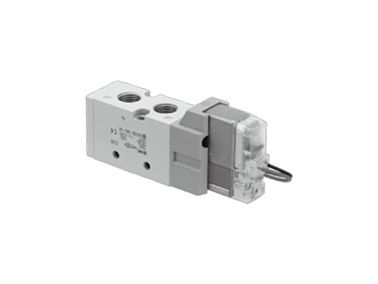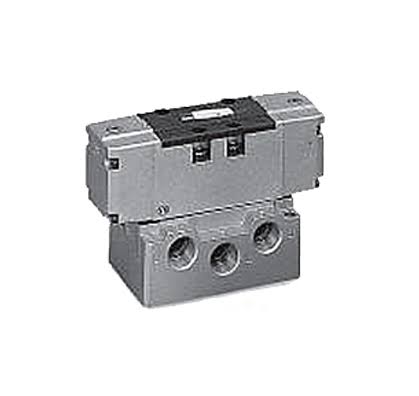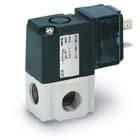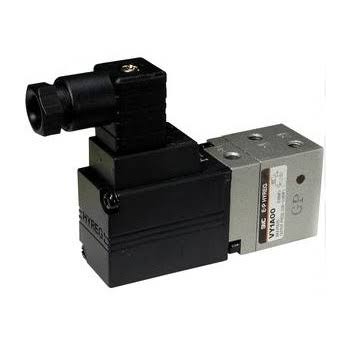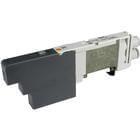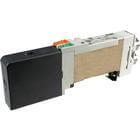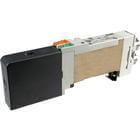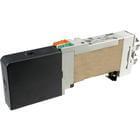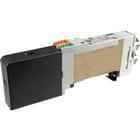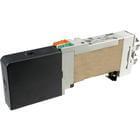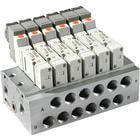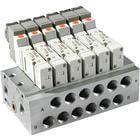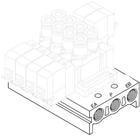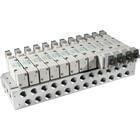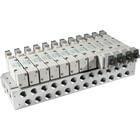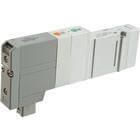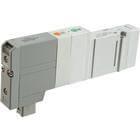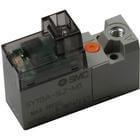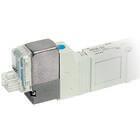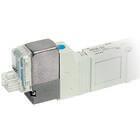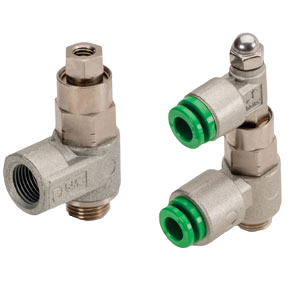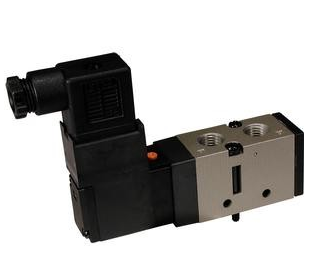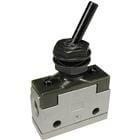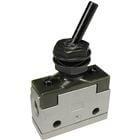SMC Directional control valves
IN STOCK!
5-port pilot operated solenoid valve
IN STOCK!!!
Valves
- Max operating temperature: 60 ° C
- Voltage - 220 V
- Power consumption: 2 W
IN STOCK!!!
Solenoid Valve
- Voltage: 24V DC
- Body: O (For manifold)
- Pressure: standard type 0.7 MPa
IN STOCK!!!
Hybrid regulator
- Max effective area: 670 mm
- Power supply: 24 V DC
- Signal voltage: 1 to 5 V DC
- SQ1*3*
- 1000 Series
- 5 Port Solenoid Valve
- Plug-in Type (New Product)
- SQ2*3*
- 2000 Series
- 5 Port Solenoid Valve
- Plug-in Type (New Product)
- SQ2*3*
- 2000 Series
- 5 Port Solenoid Valve
- Plug-in Type (New Product)
- SQ2*3*
- 2000 Series
- 5 Port Solenoid Valve
- Plug-in Type (New Product)
- SQ2*3*
- 2000 Series
- 5 Port Solenoid Valve
- Plug-in Type
- SQ2*3*
- 2000 Series
- 5 Port Solenoid Valve
- Plug-in Type (New Product)
- SQ2*3*
- 2000 Series
- 5 Port Solenoid Valve
- Plug-in Type (New Product)
- SS5Y3
- 3000 Series
- Bar Stock Manifold
- Individual Wiring
- SS5Y3
- 3000 Series
- Bar Stock Manifold
- Individual Wiring
- SS5Y3
- 3000 Series
- Bar Stock Manifold
- Individual Wiring
- SS5Y5
- 5000 Series
- Bar Stock Manifold
- Individual Wiring
- SS5Y7
- 7000 Series
- Bar Stock Manifold
- Individual Wiring
- SS5Y7
- 7000 Series
- Bar Stock Manifold
- Individual Wiring
- SS5Y7
- 7000 Series
- Bar Stock Manifold
- Individual Wiring
- SSQ2000-P
- Individual SUP Spacer Assembly for SQ2000
- SV1000
- 5 Port Solenoid Valve
- All Types
- SV1000
- 5 Port Solenoid Valve
- All Types
- SY100
- 3 Port Direct Operated Valve
- Rubber Seal
- SY3000-26
- Blanking plate for SX3000
- Type 20(P/N) - 41(P/N) - 42(P/N)
- SY3000
- Blanking Plate Assembly
- SY3000
- 5 Port Solenoid Valve
- All Types
- SY3000
- 5 Port Solenoid Valve
- All Types
Valve
- EVM100
- 100 Series
- 2/3 Port Mechanical Valve
- European
- EVM100
- 100 Series
- 2/3 Port Mechanical Valve
- European
Overview of SMC Products
SMC was founded in 1959 in Tokyo, Japan as a manufacturer of filters and filter systems based on sintered metals under the name Sintered Metal Corporation. The evolution from basic pneumatics to advanced automation equipment has earned the company a 30% global market share and a 65% market share in Japan.
In 1961, the company begins to produce pneumatic components for main air preparation, by 1970 cylinders are also included in the product range.
In 1967 - the opening of the first representative office of SMC abroad (Australia), and in 1976 the first representative office in Europe (Switzerland) was opened. Currently, the company's offices are located in 83 countries around the world.
Today, 36 company plants operate worldwide, in accordance with ISO9001 and ISO 14001 standards. The Russian SMC plant has been operating in the Moscow region since 2011.
In 1985, the name Sintered Metal Corporation was changed to SMC Corporation to be listed on the Japan Stock Exchange in 1987. But let's focus on the products the company manufactures. There are a huge number of positions in the product line, but today we will take a closer look at SMC directional control valves.
SMC Directional Control Valves
SMC directional control valves and manifolds direct air to pneumatic actuators, vacuum equipment, and as control air for large-scale industrial process valves, making them indispensable in industrial automation applications.
SMC pneumatic valves can be operated manually, pneumatically, or electrically. They can also be connected to an industrial Fieldbus and Ethernet network with I/O capabilities for feedback from sensors and actuators using protocols such as EtherNet/IP, PROFINET, EtherCAT, DeviceNet, Profibus, or IO-Link (IEC 61131-9).
SMC valves feature energy-saving coils with low power consumption, high flow rates (Cv, SCFM), and fast response times for exceptional reliability and durability.
There are three types of valves.
- Manual valves are operated by levers or paddles that require force to open and close the valve. Sometimes spring force is required to restore the valve position. In contrast, some manual valves use a lever or an external pneumatic or hydraulic signal to reset the spool.
- Mechanically actuated valves are more prone to wear as they exert force through cams, wheels, and rollers.
- Hydraulically actuated valves are much more reliable than other control methods. In addition, they are designed to be more accurate as they operate at much higher pressures than a pneumatic control valve.
Applications of SMC Directional Control Valves
Directional control valves are used in the agricultural, industrial, and mobile industries to provide smooth operation, low-pressure drop, and fast response for precise flow control in a lightweight design valve. These valves are rated for 2000 psi and flow rates up to 10 GPM. Their applicability makes them more and more in demand and is used in many applications such as.
- Car transporters
- Equipment - Tractors
- assembly lines
- Energy production
- Marine equipment
- construction machines
- mining machines
- Loading and unloading cranes
- Trucks and drilling rigs
Installation and Maintenance of SMC Directional Control Valves
When installing the air directional control valve, pay attention to the following.
Ensure that scale, welding chips, and other foreign materials are removed from the process pipe to which the control valve will be connected before installation.
- When installing a control valve, ensure that the direction of process fluid flow matches the direction of flow indicated on the valve body connection flanges.
- Install the control valve in such a position that its actuator is vertical.
- Be careful that the edges of the gaskets connecting the pipe do not protrude into the process pipe. Verify that the selected gasket material is suitable for the process fluid.
- Take appropriate measures to avoid applying too much force to the control valve from the process piping. Be careful when tightening the flange bolts to avoid uneven tightening which can cause unwanted mechanical stress.
- After installing the control valve and before connecting the air pipe to the actuator, apply clean compressed air under the air pipe to remove dust and other foreign matter from the inside of the air pipe.
- There must be enough space above the drive to remove it.
- Install the control valve in a location where the ambient temperature does not exceed the actuator's specified temperature limit.
- Make sure the actuator pointer, positioner, and handwheel (if any) are installed in the correct direction.
Before operating the control valve, check and confirm the following to ensure that all conditions are correct and safe.
- Verify that the direction of flow marked on the control valve matches the direction of process fluid flow.
- Make sure the diaphragm bolts and nuts are securely tightened.
- Make sure the cover screws are securely tightened.
- Make sure the fork clamp bolt is securely tightened.
- Make sure that the clamping bolts of any accessories (positioner, control valve, etc.) are securely tightened.
- Make sure the air connection to the actuator is secure and there is no air leakage.
- Ensure that the stem connector bolts connecting the actuator stem to the valve stem are securely tightened.
- Check that the actuator stem and valve stem are not deformed or have other signs of damage.
- Verify that the control valve operates smoothly through the full range of the lift scale.
- Make sure the actuator spring is compressed correctly.
- Make sure the gland bolts are tight enough.
- If asbestos packing is used in the control valve, it is recommended to lubricate it with an oil can.
- If the control valve is equipped with a handwheel, make sure the operating nut indicator is in the AUTO position and the handwheel is locked.
